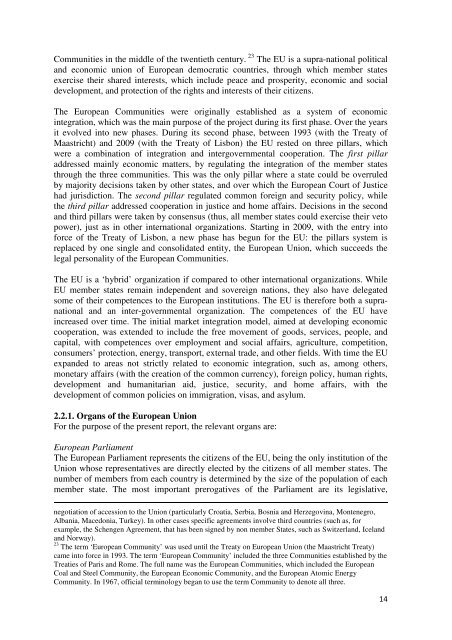Johanna Westeson - The ICHRP
Johanna Westeson - The ICHRP
Johanna Westeson - The ICHRP
Create successful ePaper yourself
Turn your PDF publications into a flip-book with our unique Google optimized e-Paper software.
Communities in the middle of the twentieth century. 23 <strong>The</strong> EU is a supra-national political<br />
and economic union of European democratic countries, through which member states<br />
exercise their shared interests, which include peace and prosperity, economic and social<br />
development, and protection of the rights and interests of their citizens.<br />
<strong>The</strong> European Communities were originally established as a system of economic<br />
integration, which was the main purpose of the project during its first phase. Over the years<br />
it evolved into new phases. During its second phase, between 1993 (with the Treaty of<br />
Maastricht) and 2009 (with the Treaty of Lisbon) the EU rested on three pillars, which<br />
were a combination of integration and intergovernmental cooperation. <strong>The</strong> first pillar<br />
addressed mainly economic matters, by regulating the integration of the member states<br />
through the three communities. This was the only pillar where a state could be overruled<br />
by majority decisions taken by other states, and over which the European Court of Justice<br />
had jurisdiction. <strong>The</strong> second pillar regulated common foreign and security policy, while<br />
the third pillar addressed cooperation in justice and home affairs. Decisions in the second<br />
and third pillars were taken by consensus (thus, all member states could exercise their veto<br />
power), just as in other international organizations. Starting in 2009, with the entry into<br />
force of the Treaty of Lisbon, a new phase has begun for the EU: the pillars system is<br />
replaced by one single and consolidated entity, the European Union, which succeeds the<br />
legal personality of the European Communities.<br />
<strong>The</strong> EU is a ‘hybrid’ organization if compared to other international organizations. While<br />
EU member states remain independent and sovereign nations, they also have delegated<br />
some of their competences to the European institutions. <strong>The</strong> EU is therefore both a supranational<br />
and an inter-governmental organization. <strong>The</strong> competences of the EU have<br />
increased over time. <strong>The</strong> initial market integration model, aimed at developing economic<br />
cooperation, was extended to include the free movement of goods, services, people, and<br />
capital, with competences over employment and social affairs, agriculture, competition,<br />
consumers’ protection, energy, transport, external trade, and other fields. With time the EU<br />
expanded to areas not strictly related to economic integration, such as, among others,<br />
monetary affairs (with the creation of the common currency), foreign policy, human rights,<br />
development and humanitarian aid, justice, security, and home affairs, with the<br />
development of common policies on immigration, visas, and asylum.<br />
2.2.1. Organs of the European Union<br />
For the purpose of the present report, the relevant organs are:<br />
European Parliament<br />
<strong>The</strong> European Parliament represents the citizens of the EU, being the only institution of the<br />
Union whose representatives are directly elected by the citizens of all member states. <strong>The</strong><br />
number of members from each country is determined by the size of the population of each<br />
member state. <strong>The</strong> most important prerogatives of the Parliament are its legislative,<br />
negotiation of accession to the Union (particularly Croatia, Serbia, Bosnia and Herzegovina, Montenegro,<br />
Albania, Macedonia, Turkey). In other cases specific agreements involve third countries (such as, for<br />
example, the Schengen Agreement, that has been signed by non member States, such as Switzerland, Iceland<br />
and Norway).<br />
23 <strong>The</strong> term ‘European Community’ was used until the Treaty on European Union (the Maastricht Treaty)<br />
came into force in 1993. <strong>The</strong> term ‘European Community’ included the three Communities established by the<br />
Treaties of Paris and Rome. <strong>The</strong> full name was the European Communities, which included the European<br />
Coal and Steel Community, the European Economic Community, and the European Atomic Energy<br />
Community. In 1967, official terminology began to use the term Community to denote all three.<br />
14
















